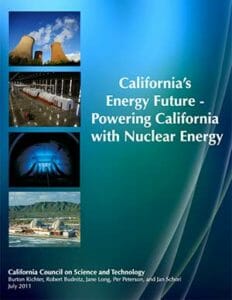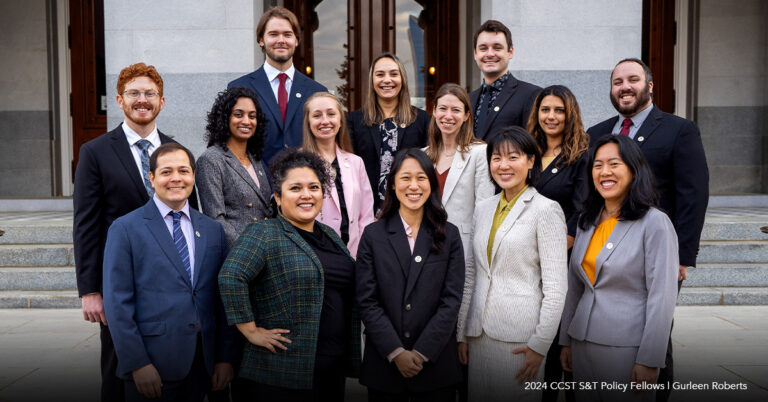Update: Applications for the CCST Science & Technology Policy Fellowship Have Closed
California’s Energy Future: Powering California with Nuclear Energy
June 1, 2011 | CCST Newsroom, Press Releases | Contact: M. Daniel DeCillis
 A report by the California Council on Science and Technology (CCST) released today examines the potential and challenges in developing enough nuclear power to meet a large fraction of California’s electricity demand in the year 2050.
A report by the California Council on Science and Technology (CCST) released today examines the potential and challenges in developing enough nuclear power to meet a large fraction of California’s electricity demand in the year 2050.
“California’s Energy Future – Powering California with Nuclear Energy” was produced as input to the CCST report, “California’s Energy Future – The View to 2050” issued in late May that summarized for state leaders how California can reduce greenhouse gas emissions to 80 percent below 1990 levels by 2050, the goal set in 2005 by executive order S-3-05. The nuclear power report estimates that roughly 30 new nuclear power plants could provide two-thirds of California’s electric power in 2050.
“Powering California with Nuclear Energy” looks at a highly charged issue from a range of perspectives, from realistic to extreme scenarios. Its five authors include: the chair, Burton Richter, professor in the physical sciences at Stanford University and director emeritus at the University’s Linear Accelerator Center; Robert J. Budnitz, an expert on nuclear power safety, security and radioactive waste management at the University of California’s Lawrence Berkeley National Laboratory; Per F. Peterson, professor and chair of the Department of Nuclear Engineering at the University of California, Berkeley; Jan Schori, former general manager and CEO of the Sacramento Municipal Utility District, SMUD, the nation’s sixth largest publicly owned electric utility; and Jane C.S. Long, associate director at large for Lawrence Livermore National Laboratory and co-chair of the California’s Energy Future study.
Population growth and energy demand will eventually force a decision on California’s energy strategy, especially with the requirement for drastic reduction in emissions. “By 2050, California’s population is expected to rise to 55 million people. That increase, accompanied by economic growth, will likely require a doubling in electricity production, but with virtually no emissions, to meet state goals,” says Jane Long. “That is why nuclear power could prove one important option for meeting those strict and necessary standards.”
The report points out that there are no technical barriers to large-scale deployment of nuclear power in California. There are, however, legislative barriers and public acceptance barriers that have to be overcome to implement a scenario that includes a large number of new nuclear reactors.
“Nuclear power is a strong contender for zero-emissions energy because it can provide constant, or ‘baseload,’ power that can complement renewable energy sources such as solar and wind. While clean, many renewable energy sources produce power intermittently: if there’s no sunlight and no wind, there’s no power. However, a constant base output of nuclear power could make it much easier to deal with the highly variable power levels from renewables,” points out chairman Burton Richter. California’s law requires at least 33% of electricity generation be provided with renewable energy.
In exploring nuclear power, the new report makes an assumption that any large-scale growth in nuclear energy in California will reflect large-scale nuclear growth worldwide, which is expected to reduce construction costs. “Experience world-wide has shown that the cost of nuclear power could decrease significantly if plant designs are standardized,” remarked Per Peterson.
The report clearly acknowledges current, well-known hurdles to any expansion in nuclear energy production. Spent fuel storage and safety in light of tsunami and earthquake damage to Japanese plants last winter in Fukushima are outlined, along with a brief discussion of global weapons proliferation. “We still have a lot to learn from the Fukushima incident and what it means for California,” says Burton Richter.
Reactors in the US are old; they are what are called Generation II (GEN II). Most of the newer reactors under construction mainly in Asia are GEN III and have simplified safety systems that need less operator intervention. The newest are called GEN III+ and have still more passive systems. The Fukushima accident has triggered a Nuclear Regulatory Commission review of standards and procedures. At the time of this report the review is not yet complete but is expected to be out in few weeks. It is worth noting that none of California’s reactors operating today are the type that had problems at Fukushima.
The report also takes into account possible advances in Generation IV nuclear power technology that could substantially reduce waste generation. Systems that rely on advanced fission approaches or even fusion are identified as possible longer-term solutions, but cannot be commercially available until mid-century.
Other areas of the report examine costs; realistic and extreme scenarios regarding supply and demand; fuel availability; and where nuclear power plants could be located. In the latter section, on siting reactors, the report describes the Diablo Canyon and San Onofre reactor plants as being designed to withstand very large earthquakes, and states that earthquake issues should not be a barrier to deploying additional reactors in California, adding that there are also inland sites with lower seismicity.
One section of “Powering California with Nuclear Energy” encapsulates point by point what must happen on a state and national level to make a large expansion of nuclear power practical. An expansion of nuclear power will require loan guarantees and progress toward a resolution to waste disposal, the subject of a soon-to-be-released federal Blue Ribbon Commission interim report. Other points look ahead to 2020, when current California regulations demand that 33% of electricity generation come from renewable sources, and other new generation is limited to low-carbon sources.
The report notes that the Department of Energy needs to develop a long-term strategic plan for nuclear research that would lead to safer and more efficient reactors that would ease the waste disposal problem. A version of such a plan has been submitted to Congress.
Jane Long points out “Expansion of nuclear power in California requires growth in public acceptance, which has been eroded by the Fukushima incidents. The question is will relatively low energy costs, nearly zero greenhouse gas emissions, and the need for energy reliability change this position over time?”
Contributions toward underwriting “Powering California with Nuclear Energy” came from the Stephen Bechtel Fund, California Energy Commission and Lawrence Livermore National Laboratory, with support from the California Air Resources Board.
The CCST is a nonpartisan, impartial, nonprofit created in 1988 by a unanimous vote of the California Legislature. It is designed to offer expert advice to the state government and to recommend solutions on science and technology-related policy issues. The CCST is governed by a board of directors composed of representatives from its sponsoring academic institutions, from the corporate and business community, as well as from the philanthropic community.






